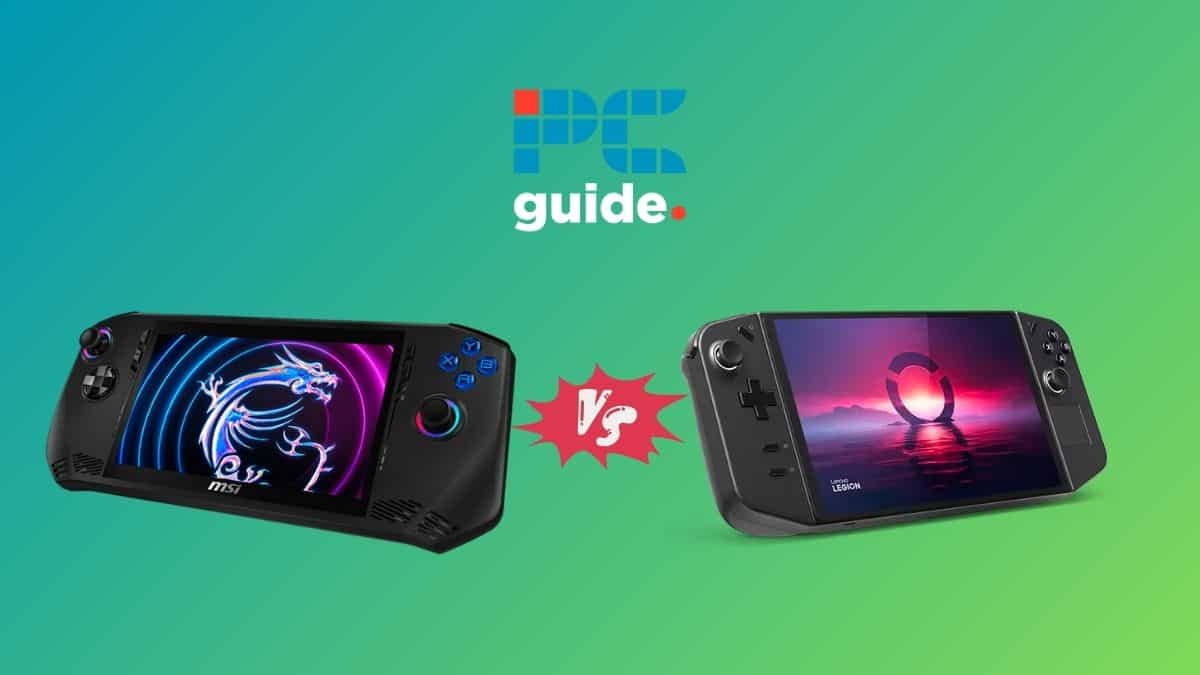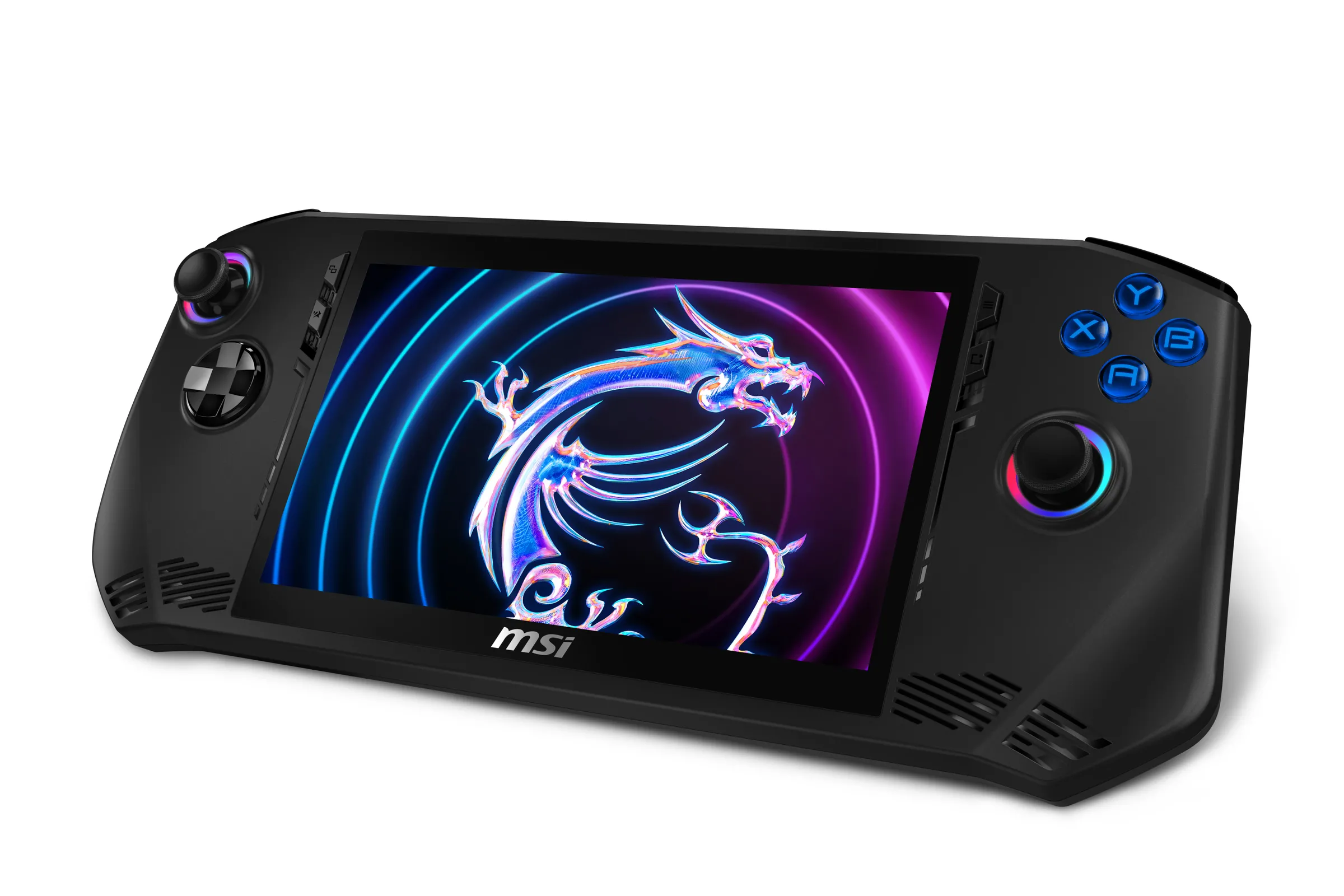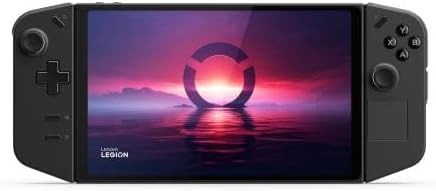MSI Claw vs Legion Go – which is better?

Table of Contents
As debut handhelds from MSI and Lenovo, these two devices are both making their mark on the portable gaming PC scene – let’s compare the MSI Claw vs the Legion Go. CES 2024 saw MSI finally announce its own handheld console, and while portable gaming PCs are niche, it’s got surprisingly strong competition. Notably, Lenovo’s own unique handheld offering that’s fairly new to the market itself, having only been released back in October 2023. So, in this article, we’ll unpack how the features, specs, and pricing compare across the MSI Claw and the Lenovo Legion Go to establish which could be the better handheld on paper.
MSI Claw vs Legion Go specs
| Specification | MSI Claw | Lenovo Legion Go |
|---|---|---|
| Display | 7” FHD (1920×1080), 120Hz | 8.8″ QHD (2560×1600), 144Hz |
| Dimensions | 294 x 117 x 21.2mm | 298.83 x 131 x 40.77mm |
| Weight | 675 g | 640 g |
| CPU | Intel Core Ultra 7 155H | AMD Ryzen Z1 Extreme |
| Graphics | Intel Arc | AMD Radeon |
| RAM | 16GB | 16GB |
| Display | 7-inch, 120Hz, 1080p LCD | 8.8-inch, 144Hz, QHD LCD |
| Battery Capacity | 53wHr | 49.5wHr |
| Storage | Up to 1TB SSD | Up to 1TB SSD |
| Memory | 16GB LPDDR5-6400 RAM | 6GB LPDDR5X |
| Operating Software | Windows 11 | Windows 11 |
| Price | Starting at $699 | Starting at $699 |
MSI Claw vs Legion Go features
Design and display
When it comes to design, the MSI Claw is almost identical in design and form to the Asus ROG Ally with its 7″ FHD thick bezel display, but with larger ergonomic grips and two additional shoulder buttons bringing its weight up to 675 grams. As well as making use of eye-catching RGB lighting across its front buttons, the leverage of Hall effect triggers and thumbsticks designed to be immune to stick drift gives the Claw an extra advantage over its competitors. It also introduces Intel’s XeSS upscaling technology, which aims to increase frame rates via AI. While its full HD LCD panel, 120 Hz refresh rate, and upscaling are impressive, display is one of the areas in which the MSI Claw falls short compared to the Legion Go.
Prime Day is finally here! Find all the biggest tech and PC deals below.
- Sapphire 11348-03-20G Pulse AMD Radeon™ RX 9070 XT Was $779 Now $739
- AMD Ryzen 7 7800X3D 8-Core, 16-Thread Desktop Processor Was $449 Now $341
- ASUS RTX™ 5060 OC Edition Graphics Card Was $379 Now $339
- LG 77-Inch Class OLED evo AI 4K C5 Series Smart TV Was $3,696 Now $2,796
- Intel® Core™ i7-14700K New Gaming Desktop Was $320.99 Now $274
- Lexar 2TB NM1090 w/HeatSink SSD PCIe Gen5x4 NVMe M.2 Was $281.97 Now $214.98
- Apple Watch Series 10 GPS + Cellular 42mm case Smartwatch Was $499.99 Now $379.99
- ASUS ROG Strix G16 (2025) 16" FHD, RTX 5060 gaming laptop Was $1,499.99 Now $1,274.99
- Apple iPad mini (A17 Pro): Apple Intelligence Was $499.99 Now $379.99
*Prices and savings subject to change. Click through to get the current prices.
In terms of display quality, the Legion Go takes it up a notch with its larger 8.8-inch LCD panel, offering a QHD 2560×1600 resolution and a remarkable 144Hz refresh rate. The layout of the analog sticks is similar to the Claw, but there are a few design differences in the Legion Go. Not only is it bigger, but similar to the functioning of the Nintendo Switch and its Joy-Cons, gamers can separate the controllers from the main body of the Legion Go, allowing for more comfortable and flexible modes of gameplay. The right controller even includes an optical mouse sensor, providing precise control for first-person shooter games and making the device even more useable as a portable PC for productivity.
Performance
Hardware is where the next big difference between the two consoles comes into play, as we’ve got an Intel vs AMD throw-up. When it comes to performance, the Legion Go relies on AMD’s Ryzen Z1 Extreme processor paired with 16GB of LDDR5 RAM, meaning this device is optimized to thrive under demanding workloads.
The MSI Claw, however, breaks the mold by being the first gaming handheld to feature an Intel Core Ultra processor. With its Core Ultra 7 155H chip, comprising six power cores, eight e-cores, and two low-power e-cores, the Claw aims to provide exceptional performance. While benchmark comparisons are yet to be seen, we expect the Claw to hold its ground against the competition. On the whole, there’s no massive quantifiable difference between the two handsets so far, and it will be interesting to see how integrated Arc graphics perform in a mobile configuration.
Software
Both devices run Windows 11 natively, and have their own custom overlay UI software for easy game browsing, launching, and control customization. However, the Claw sets itself apart by offering the ability to run Android titles via the App Player, expanding the gaming library beyond PC games. Additionally, based on Intel hardware, MSI’s console offers the advantage of Thunderbolt 4 on its USB-C port, potentially providing better options for external graphics and displays. However, the Legion Go natively supports Xbox Game Pass, meaning that your Game Pass subscription could get you over 400 titles straight away.
Battery life
Naturally, long handheld gaming sessions demand reliable battery life. The Legion Go comes with a 49.5wHr battery, which is quite impressive for a gaming handheld device, and offers a versatile three to twelve hours gameplay depending on settings. However, the MSI Claw takes the lead with its impressive 53wHr battery, claiming to be the largest in any handheld gaming console. Apparently providing up to two hours of battery life for non-stop gameplay on full load, the Claw ensures that the AAA gaming experience remains uninterrupted. Additionally, the Claw incorporates a cooling system with air vents that MSI quote as 50 percent larger than the Legion Go, ensuring optimal performance even during intense gaming sessions.
MSI Claw vs Legion Go price
Price plays a crucial role in the decision-making process for any gaming enthusiast, and it looks like we’ve got two expensive consoles on our hands. In terms of pricing, both the Legion Go and MSI Claw fall within the same price segment, making it a tough choice for gamers. The Legion Go has a starting price of $699 for the base 512 GB model, and $799 for the 1TB variant.
As for the Claw, MSI only recently detailed the full pricing of its three variants, and it’s pretty much in line with what we expected. The base model, featuring Core Ultra 5 and 512GB storage offers, starts at $699, so offers a comparable starting price point to the Legion Go. The higher-end models, equipped with the powerful Core Ultra 7 processor, come in at $749 for 512GB and $799 for 1TB storage.
Is the MSI Claw better than the Legion Go?
As the gaming handheld market becomes increasingly fierce, the MSI Claw and the Lenovo Legion Go emerge as worthy competitors to the reigning Valve Steam Deck OLED and ROG Ally. While the Claw sets itself apart with its Intel-powered performance and unique features like XeSS upscaling technology, the Legion Go impresses with its larger display and removable controllers. In terms of which one is better, the call between the MSI Claw and the Legion Go depends on your specific needs and preferences. However, a decisive verdict might become clearer following hands-on experience and reviews of the Claw after its official launch



